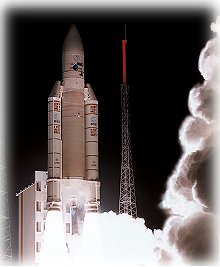At this time, 23 Jan. 2000, there are 17 Amateur Radio Satellites in orbit. These "birds" were built
 by American, Russian, Japanese,
United Kingdom, Germans, and others in part or completely. Below you can
see a breakdown of how they are used.
by American, Russian, Japanese,
United Kingdom, Germans, and others in part or completely. Below you can
see a breakdown of how they are used. ![]()
At
this time, 23 Jan. 2000, there are 17 Amateur Radio Satellites in
orbit. These "birds" were built  by American, Russian, Japanese,
United Kingdom, Germans, and others in part or completely. Below you can
see a breakdown of how they are used.
by American, Russian, Japanese,
United Kingdom, Germans, and others in part or completely. Below you can
see a breakdown of how they are used.
For Voice , Morse Code
(US)AO-10, Oscar
10 Launched 1983/June/16 High-altitude with a elliptical
orbit. Period 11Hr-39 Minutes. (Pictured on the right)
(US)AO-27, AMRAD-Oscar 27 Launched 1993/Sep/26 Polar orbit (Low Earth
Orbit) Period 101 Minutes.
(JA) FO-20, Fuji Oscar 20 Launched 1990/Feb./7 Polar orbit (Low Earth Orbit)
Period 112 Minutes.
(JA) FO-29, Fuji Oscar 29 Launched 1996/Aug/17 Polar orbit (Low Earth Orbit)
Period 112 Minutes.
(Russia) RS12/13 Radio Sputnik Launched 1991/Feb./5 Polar orbit (Low Earth Orbit)
Period 105 Minutes.
(Russia) RS 15 Radio Sputnik Launched 1994/Dec./4 Polar orbit (Low Earth Orbit)
Period 128 Minutes.
Digital Transponders
This group,
consisting of 11 "birds", are for the digital modes, packet, Store
and Forward systems and some have cameras and other experiments. I will not
detail this group.
The Future is
here...AO40 is launched !!!
At 01:07 UTC 16
Nov. 2000, Amsat's P3D (now called AO40) lifted off at the Arianespace Center at
Kourou Guana and becomes the largest at 2.23meters, heaviest at 1,346 Lbs and
the most complex satellite ever launched by Amsat.
At 13:40 UTC, the first window opened for the Ohio area and after a short search
the beacon was located at 145.898Mhz + - doppler shift. The beacon is very
strong about 20-30db over the noise and solid thought out the pass.
Sorry to add , within a few day the bird had lost the 144 Mhz up link and the
435Mhz downlink for good and will depend on SBand 2.4 Ghz and 1.2 Ghz to carry
the load.



2 Meter Telemetry Sounds from AO-10
AO-40 with 9 uplinks, 6 down links,and 5 general beacons will offer amateur radio operators many combinations and great flexibility from base or mobile stations.
After almost 10 years of planning, building, and
4-million dollars the P3D (AO-40) project finally "lives".
![]()
Contacts via the Satellites (click on the picture for a larger image)






These are only a few cards from my satellite
contacts. Note: All Continents, oceanic, and Antarctica are represented.